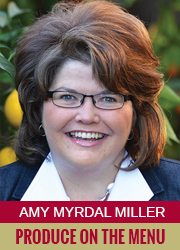 Putting more produce on the plate has been a long-time goal for members of The Culinary Institute of America Healthy Menus R&D Collaborative. In fact, this strategic priority was one of the first two identified by operators when the Collaborative was formed in 2010. (The other was sodium reduction.) Foodservice operators recognize fresh produce offers many nutrition and health, as well as business, benefits.
Putting more produce on the plate has been a long-time goal for members of The Culinary Institute of America Healthy Menus R&D Collaborative. In fact, this strategic priority was one of the first two identified by operators when the Collaborative was formed in 2010. (The other was sodium reduction.) Foodservice operators recognize fresh produce offers many nutrition and health, as well as business, benefits.
Research from Chicago-based Datassential shows consumers view foodservice operations that feature fresh produce in their advertising or on menus and menu boards as more committed to customers’ health and well-being than restaurants that rarely feature fresh produce. Fresh produce is a positive health cue for consumers, even if perception doesn’t match reality.
If your company wants to sell more produce to large foodservice operations, it will take more than a desire to grow your business. You need a strategic approach and partners who can help with the research and relationship-building needed to be successful. Here are five critical questions to consider.
Who are the right partners to bring on board to help develop strategy and relationships?
Does your team already have an experienced foodservice marketer? If not, hire one, either as a consultant or a full-time employee. What works for retail may make little sense for a foodservice customer. Having a foodservice expert on your team with existing business relationships can help make introducing new produce items to foodservice easier and more successful.
What strengths can you offer a foodservice customer?
Do you have an internal R&D team that can take on any customer challenge and offer a solution? Do you have custom packing options for foodservice units that need smaller volume? Do you work with distributors who can deliver smaller loads more often to foodservice operations with limited storage space for perishable ingredients? Do you have culinary experts on your team who can work with the customer’s menu R&D team to develop new produce-centric menu items? Do you have multiple growing regions, or do you specialize in local growing and sourcing? Some customers may want local or regional sourcing while others may demand broader sourcing that protects them from supply chain issues caused by Mother Nature.
If your company wants to sell more produce to large foodservice operations, it will take more than a desire to grow your business.
What foodservice companies are your best targets?
Do you want to generate media excitement around a new produce item with limited supply? Then stick to upscale, fine dining operations where a limited supply of specialty produce items is not an issue. Do you have a new produce item for which you want to test consumer acceptance? Consider partnering with campus dining operations that can put new items on their menus much more quickly than large chains. Do you have a new produce item that could bring a lot of excitement to a tired menu category? For example, can you provide pre-cut fruit, including excellent melons, for fruit cups that deliver premium flavor, adequate shelf life and a competitive price?
What new or improved produce items can you offer a foodservice customer?
Do you have a new produce item, or are you offering a foodservice customer a solution to a current shelf-life, packing issue or labor issue? Do you have the right volume to meet your target customer’s needs? Are you offering seasonal or year-round sourcing? While some foodservice operations love limited time offers (LTOs), many others prefer menu offerings (and ingredients) that fit with their menus year-round.
Do you have a story to tell that pairs well with your target customer’s brand identity?
As consumers express more interest in where their food comes from, having a good story to tell is a very valuable asset. Many foodservice brands are shaping their brand identities with values that resonate with their customers. Are you a family owned company? Do you use unique growing practices that promote sustainability? Are you committed to superior quality and premium produce? Are you investing in R&D to bring produce to market that has superior taste, flavor or nutrient profiles? Give a potential foodservice customer a chance to tell your story as part of their story, especially if it relates to the new produce item you’re trying to sell.
Amy Myrdal Miller, MS, RDN, FAND is a farmer’s daughter from North Dakota, award-winning dietitian, culinary nutrition expert, and founder and president of Farmer’s Daughter Consulting, Inc. She is the director of The Culinary Institute of America Healthy Menus R&D Collaborative. You can learn more about her business at farmersdaughterconsulting.com, and you can follow her insights on food and flavor on Twitter @AmyMyrdalMiller.





